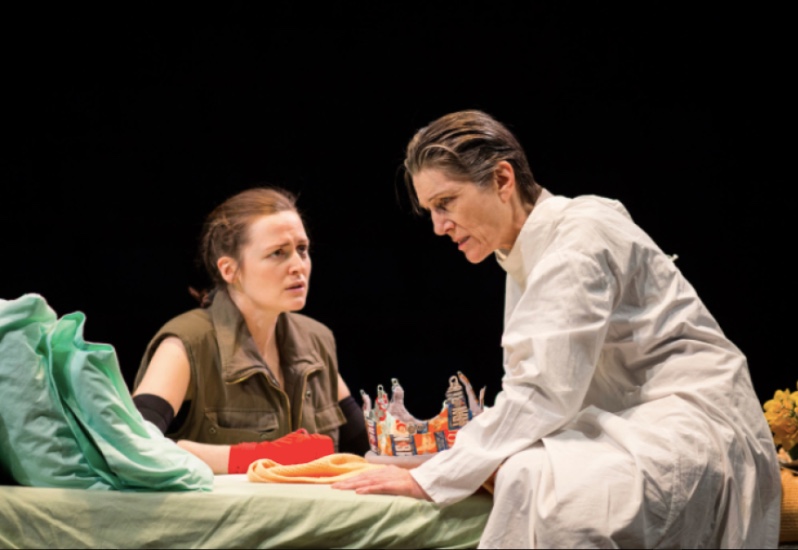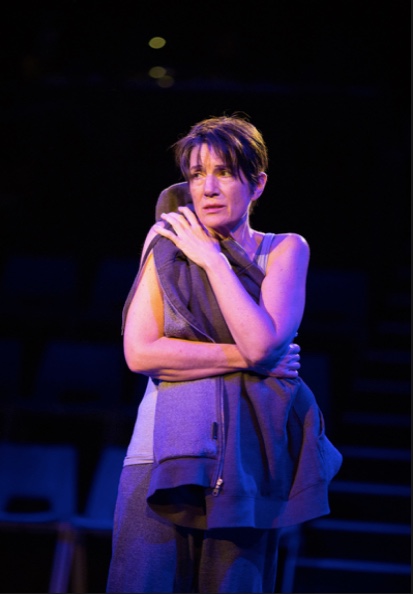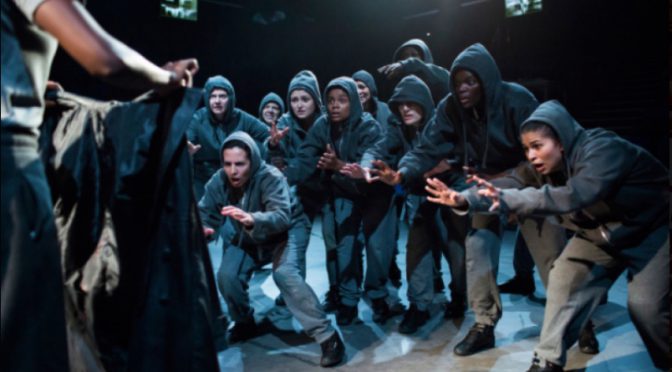by Hailey Bachrach, PhD candidate researching gender in early modern history plays in collaboration with Shakespeare’s Globe Theatre, @hbachrach.
If you’ve heard of director Phyllida Lloyd’s Shakespeare Trilogy, which debuted at the Donmar Warehouse from 2012 to 2016 and was released in full on BBC iPlayer on 17 June, you’ve probably heard of its premise: it is performed by a company made up entirely of women, and framed as plays put on by a group of female prisoners. The three plays—Julius Caesar, Henry IV (the two parts combined into one), and The Tempest—are all intimately concerned with questions of masculinity and male relationships—fathers, brothers, sons—and are all notoriously light on female characters.
The prison framing device means, however, that they are not devoid of a female presence. There is no attempt at prosthetics or illusion in the production’s costumes. The actors wear prison-issue grey sweatpants and t-shirts, with accessories to designate changes of character. When Henry IV opened in 2014, Harriet Walter, who stars in all three productions, wrote that ‘our neuter prison garb … helps the audience put aside any questions of “Are they men playing women or women playing men?”… I would argue that when the cast are all women, we can look beyond gender to our common humanity’.
Can we look beyond gender in these Shakespearean adaptations…?
Within the plays themselves, however, neither Shakespeare’s characters nor the prisoner-characters the actors play are looking beyond gender. A world that logically should be ‘neuter’ instead deploys staging strategies to maintain the texts’ gender hierarchies, and to differentiate and isolate female characters.

Most conspicuously, both Brutus’s wife Portia in Julius Caesar and Hotspur’s wife Kate in Henry IV are linked with motherhood: Clare Dunne’s Portia is pregnant, and Sheila Atim’s Kate is constantly cradling a baby. These two characters have remarkably similar opening scenes, in which both women appeal to their husbands to be let in on their political plans. And in Lloyd’s version, both also commit acts of self-harm. Portia does so onstage, while speaking a line that references a ‘voluntary wound on the thigh’ that she gives to prove her strength, a strange line that productions often struggle to interpret. When Hotspur dismisses his wife’s appeal to love, insisting that he does not love her, Kate declares that ‘if you do not love me, I will not love myself’—at which point Atim draws up her sleeve to reveal what is plainly a bandaged wound from either self-injury or a suicide attempt. Both women’s self-harm—along with Portia’s eventual suicide—is thus directly linked to their husbands’ neglect.
A world in which men enact violence on one another, but women , cloistered from the battlefield, enact violence upon themselves…
Portia and Kate’s maternal roles reveal that, far from being free of gendered hierarchies, the rules of this all-woman world match the traditions of our own: mothers are confined to the home while men go forth into society. The matched instances of self-harm are a language more unique to this production, suggesting a world in which men are the people who enact violence on one another, but women are those who, cloistered from the battlefield, enact violence upon themselves.

Zainab Hasan’s depiction of Hostess Quickly in Henry IV eschews the comic befuddlement that usually marks the character, skipping over or cutting most of her comically sexual malapropisms. But the character becomes the centrepiece of what many critics like Jacqueline Rose in the LRB found to be the most striking moment of that play. A scene in which Falstaff mocks the Hostess transitions abruptly into crude contemporary sexual jokes, a game that Prince Hal (played by Clare Dunne) and the other tavern onlookers gleefully join. Hasan tearfully breaks character (that is, into her prisoner character) and runs offstage, protesting, ‘We agreed that we weren’t going to do this bit!’ Embarrassed and sullen, the other prisoners restart the scene, returning to Shakespeare’s text. But the damage has already been done.
This exchange and its blurring of the distance between prisoner-character and Shakespeare-character suggests that only some of these prisoners can use theatre to find freedom from the social constraints of their gender—in part because they find it by inhabiting a manhood that must define itself against and through the abuse of women.
The fantasy of theatrical liberation from gender thus falls apart in the face of a toxic conception of masculinity that can only locate itself in opposition.

The play-in-prison framework suggests that this is a reflection of the prisoners’ understanding of how masculinity and femininity function in the world as they know it. Each play in the trilogy begins with a recitation of statistics about the lives of female prisoners, and a summary of how the themes of the play to come relate to the life of the prisoner delivering the speech. At the beginning of Henry IV, for example, Dunne’s prisoner-actor explains that many women in prison are there because of men, either as accomplices to their partners’ crimes, or because they retaliated against abusive partners. The outlined themes are always to do with the conflicts of the male characters; the female characters, however, are where the connections to the literal circumstances of the prisoners’ lives most clearly shine through.
How can theatre become a world that does not replicate the gendered oppressions of the society these women have left behind…?
The Tempest, which has only one female character—Prospero’s daughter, Miranda—takes an altogether gentler view. The meditative, redemptive quality of this play, which grows gradually calmer and less violent than its two preceding productions, is matched by a less despairing and less binary take on gender relations. Unlike the female characters of the previous plays, Leah Harvey’s Miranda is not marked out by pointedly feminine accessories like jewellery, scarves, or long hair. When Miranda and her lover Ferdinand (played by Sheila Atim) enter for their wedding, they wear matching outfits, both in tutus and top hats with veils affixed to the back. Though Ferdinand wears a black skirt and Miranda a white, neither is obviously marked as husband or wife; rather, both are both and neither. Unburdened by the weight of social and sexual difference that has excluded the previous female characters from the plays’ promise of liberation from gender roles, Miranda need not be visibly marked as different from her partner. The hoped-for ‘neuter’ world is, at last, achieved.
Harriet Walter’s prisoner-character opens The Tempest with an explanation of how she ended up being sentenced to life in prison. There is no escape for her, and in the eyes of the law, no redemption. But as this final instalment in the trilogy gently suggests the potential of art to provide both of these things, it likewise suggests that theatre can become a world that does not replicate the gendered oppressions of the society these women have left behind.
Featured image: The company of Julius Caesar. Photo © Helen Maybanks. All images reproduced in this blog post are from this website.
You may also enjoy
Julia Pascal’s opinion piece ‘Women are being excluded from the stage. It’s time for quotas.
The Long Read: Just Women and Violence
Hailey Bachrach on ‘gender blind’ casting at Shakespeare’s Globe
Blog posts on King’s English represent the views of the individual authors and not those of the English Department, nor King’s College London.

